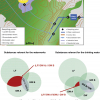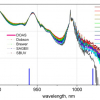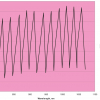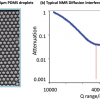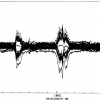Articles and Columns
Monitoring drinking water quality poses many challenges and the authors describe their approach that combines instrumental developments with new software.
With the threat of climate change, understanding the workings of our atmosphere is of crucial importance. Ozone is the most important trace gas in the stratosphere and troposphere and it is monitored by both satellite-borne and ground-based instruments. Accurate knowledge of ozone absorption cross-sections is vital for this work and described in this article.
Counterfeiting is a major problem throughout the world and transmission Raman spectroscopy proves to be a very useful tool for fast and non-destructive detection of counterfeit pharmaceuticals.
The African crested rat chews poisonous bark and then applies its saliva to specialised hairs which provide a most effective protection. Maxime Boulet-Audet and Chris Holland describe this and the use of infrared spectroscopy to learn more about this unusual animal. The new knowledge may even lead to new treatments for human cardiac conditions.
Chris Burgess and John Hammond respond to Peter Jenks' thoughts in the last issue's Quality Matters Column. Please join in the debate and add your comments at the end of the article.
Industrial environments pose potentially hazardous situations whereby workers may be exposed to various airborne toxic elements in their breathing zone. One of the main aerosol fractions of interest is welding fume, which can be determined with XRF spectrometry.
Chemical contaminants in water are of concern to all of us. This article reviews the use of mass spectrometry (MS) in environmental and wastewater analysis.
After an introduction to MALDI, DESI and SIMS, the authors describe their main applications in forensics, as well as the advantages provided in terms of sample preparation over approaches routinely used in toxicological laboratories.
Tony (A.N.) Davies is impressed with the service form the UK's EPSRC National Mass Spectrometry Service Centre.
Tea is harvested from the bud, the first leaf and the first three leaves up to a maximum of four leaves. Quality decreases from the bud down as the parts become older. This study looks at the use of NIR spectroscopy to determine optimal production using the harvested material.
Tony (A.M.C.) Davies is again telling us to “Always look at the spectrum”. This time he uses an example from the development of a NIR spectrometer to demonstrate that one doesn’t really know what’s going on until one has “looked at the spectrum”.
The reasoning behind strict compliance to an ISO Standard is logical, but the consequences can be commercially questionable, if not unsound. Peter Jenks, and many other scientists, are starting to question the commercial viability of all this regulation. What is your opinion?
TiO2 is widely used as a sunscreen UV filter and as a colouring agent in all types of cosmetic products. TiO2 has recently captured the attention of the scientific community since its safety assessment has been placed again under consideration. Inductively-coupled plasma atomic emission spectrometry (ICP-AES), square wave voltammetry (SWV) and sedimentation field-flow fractionation (SdFFF) are described in this article to characterise and quantify the TiO2 particles inside six commercial foundation creams.
Nuclear magnetic resonance (NMR) spectroscopy is one of the most powerful analytical tools used to probe details of molecular structure and dynamics. It requires very high magnetic fields and, hence, generally uses extremely large, powerful magnets. The advent of small, powerful magnets has allowed much less expensive low resolution NMR instrumentation to be designed, making it feasible to measure commercially important characteristics of dispersion behaviour and performance, including the wetted surface area of particulate suspensions and emulsion droplet size. An important additional practical application is the ability to determine competitive adsorption and/or displacement of polymers and surfactants at interfaces. This article presents a brief overview of these new approaches together with an example of each measurement.
This article shows that NIR spectroscopy offers the potential for bioprocess manufacturing companies to limit the variability in the biological production process, thereby increasing the yield and reducing the number of errors.
Applications of mass spectrometry in the clinical area have increased significantly in recent years and continue to expand. The complexity of analyses has also increased, with work being undertaken in clinical labs that would have been the reserve of research labs a few years ago.
This article surveys developments in the applications of Raman spectroscopy and the design of probes for use in endoscopes for the detection of early cancers in the throat and stomach.
Anaerobic digestion is a good solution to the joint problems of dealing with organic waste and producing “clean” energy. However, running the digesters at optimum performace is a complex business. NIR spectroscopy offers a solution to monitor a number of analytes within the reactor and in real time.
A poem with a spectroscopic theme by Professor Bill George of the University of Glamorgan.
Tony (A.M.C.) Davies stresses the importance of always looking at the spectrum, even if you [think you] know there’s nothing to learn. He relates his experience with noise in NIR spectra and what he has learnt from it. He would like us all to examine spectra for abnormality before relying on automated methods.

